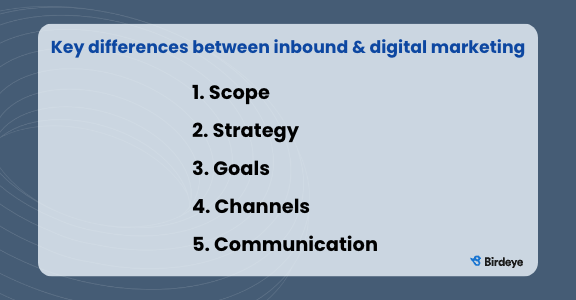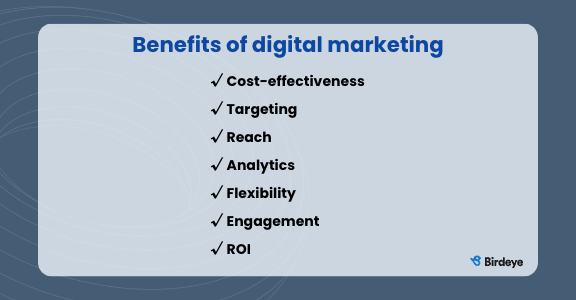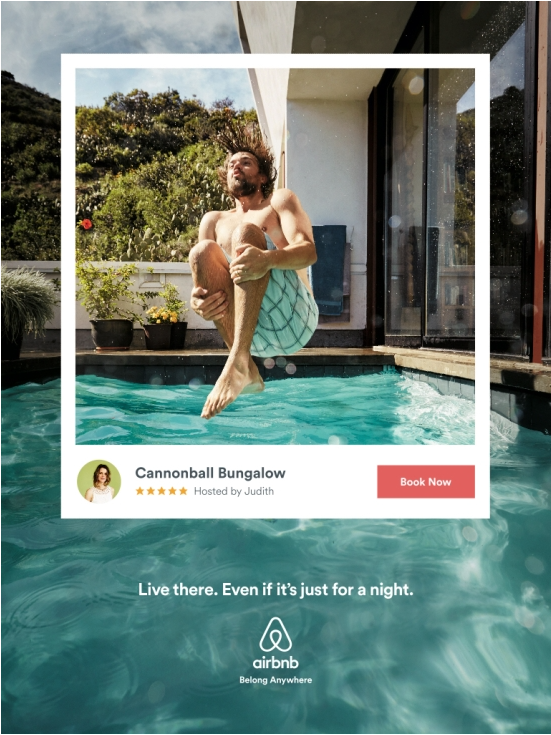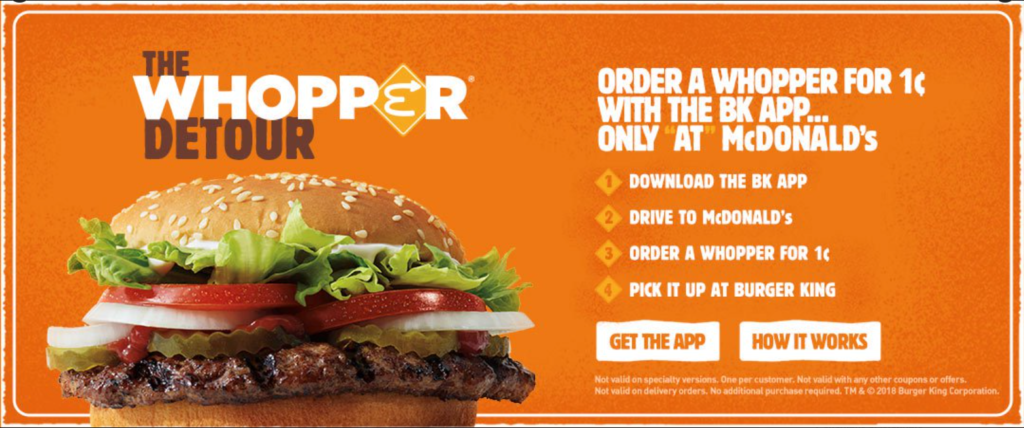Digital marketing is a powerful way to connect with your customers and grow sales. From the exciting growth of social media to the importance of data analytics and artificial intelligence (AI), today’s digital landscape presents an abundance of opportunities for marketers to connect with customers like never before. In this blog post, we’ll share everything you need to know about digital marketing, so buckle up and get ready for an exciting journey through the cutting-edge world of customer engagement.
Table of contents
- What is digital marketing?
- Why is digital marketing important?
- 5 key differences between inbound marketing and digital marketing
- 7 differences between B2B and B2C digital marketing
- How to do digital marketing
- Types of digital marketing channels
- The benefits of digital marketing
- Key performance indicators (KPIs) in digital marketing
- Digital marketing challenges
- What skills are needed in digital marketing?
- Digital marketing examples
- Implicit bias in digital marketing
- Frequently asked questions about digital marketing
- Are you ready to get started with digital marketing?
What is digital marketing?
Simply put, it’s the strategic use of online platforms and technologies to promote products or services and drive business growth. It offers businesses affordable, data-driven strategies that can be personalized and easily monitored. This enables businesses to optimize their efforts and achieve a better return on investment (ROI) compared to traditional marketing methods.

Why is digital marketing important?
There are several reasons why it’s important.
- You can focus efforts only on the prospects most likely to purchase your product or service.
- It’s more economical than outbound marketing methods.
- It evens the playing field and allows you to compete with bigger brands.
- It’s measurable.
- It’s easy to adapt and change a digital marketing strategy.
- It can improve your conversion rate and the quality of your leads.
- You can engage audiences at every stage.
5 key differences between inbound marketing and digital marketing

While at the onset, inbound marketing and digital marketing look similar, there are several differences between the two.
- Scope: Digital marketing encompasses all online marketing efforts. Inbound marketing, however, is a subset, focusing on attracting customers through valuable content and experiences.
- Strategy: Inbound marketing emphasizes creating and sharing quality content to draw prospects in. On the other hand, digital marketing strategy includes a broader range of tactics like paid advertising and SEO.
- Goals: Inbound marketing aims to establish long-term relationships and brand loyalty. And, digital marketing targets a wider range of objectives such as brand awareness, lead acquisition, and conversions.
- Channels: Inbound marketing primarily utilizes content marketing, blogs, and social media. Digital marketing, on the other hand, involves additional channels like email, pay-per-click (PPC), and affiliate marketing.
- Communication: Inbound marketing fosters two-way communication and engagement with customers. Some digital marketing tactics, like display ads, are more one-sided.
7 differences between B2B and B2C digital marketing
Although both business-to-business (B2B) and business-to-consumer (B2C) marketing shares the common goal of promoting products or services, the approach and techniques used can differ significantly.
- Target audience: B2B targets other businesses, focusing on decision-makers and influencers. B2C marketing, on the other hand, targets individual consumers with diverse needs and preferences.
- Sales cycle: B2B usually has a longer sales cycle involving multiple touchpoints, as purchasing decisions are more complex and require approval. B2C has a shorter sales cycle with simpler decision-making.
- Content focus: B2B content tends to be more informational, educational, and industry-specific, whereas B2C content is often entertaining, emotional, and lifestyle-oriented.
- Relationship-building: B2B emphasizes long-term relationships, requiring tailored communication and personalized services, while B2C often focuses on creating emotional connections to influence purchasing decisions.
- Marketing channels: B2B relies more on channels like LinkedIn, email marketing, and industry events, while B2C utilizes channels such as Instagram, Facebook, and influencer marketing to engage consumers.
- Messaging: B2B messaging highlights factors like cost-effectiveness, ROI, and problem-solving, while B2C messaging focuses on personal benefits like time-saving and lifestyle appeal.
- Metrics: B2B marketers prioritize metrics like lead quality, conversion rates, and customer lifetime value, while B2C marketers emphasize metrics like website traffic, social media engagement, and customer acquisition cost.
How to do digital marketing
To be effective with this marketing strategy, marketers need to:
- Define target audiences: Identify your ideal customer based on demographics, interests, behavior, and other relevant factors. Create buyer personas to represent different segments of your audience, which will help guide your marketing strategies.
- Set clear objectives: Establish specific, measurable, attainable, relevant, and time-bound (SMART) goals. These objectives should align with your overall business goals and help you track progress and measure success.
- Choose the right digital marketing channels: Based on your target audience and objectives, select the most appropriate digital marketing channels for your campaigns. Some common channels include SEO, PPC advertising, content marketing, social media management, email marketing, and video marketing.
- Develop a content strategy: Create a content plan that outlines the types of content you’ll produce, the platforms you’ll publish on, and the frequency of publishing. Make sure your content is relevant, engaging, and tailored to your audience’s needs and interests.
- Optimize your website: Ensure your website is user-friendly, responsive, and optimized for search engines. This includes proper keyword research, on-page SEO, technical SEO, and off-page SEO to improve visibility, drive organic traffic, and enhance the user experience.
- Execute your digital marketing campaigns: Implement your strategies across the chosen channels, ensuring consistency in messaging, branding, and targeting. Monitor and adjust your campaigns as needed for optimal performance.
- Engage with your audience: Respond to comments, questions, and feedback on your digital marketing channels to support relationships with your audience and promote brand loyalty.
- Analyze and measure results: Use analytics tools like Google Analytics, social media analytics, and email marketing platforms to track the performance of your efforts. Regularly review key performance indicators (KPIs) to determine the effectiveness of your campaigns and identify areas for improvement.
- Adjust and optimize: Based on your analysis, make data-driven adjustments to your strategies to improve performance. Continue to test and experiment with different tactics to find the most effective methods for your business.
- Stay up-to-date with industry trends: Stay in the know of the latest trends, tools, and best practices to stay competitive and adapt your strategies as needed.
By following these steps and continuing to refine your approach, you’ll be well on your way to executing effective digital marketing campaigns that drive growth and success for your business.
Types of digital marketing channels

Now let’s talk about the different types of digital marketing channels that you can use to reach and engage with your target audience, promote your brand, and drive growth.
- Search engine optimization (SEO): SEO helps to improve a website’s visibility in search engine results to drive organic traffic.
- Pay-per-click (PPC) advertising: This involves running paid ads on social media platforms or search engines, where advertisers pay for each click on their ads.
- Content marketing: Creating, publishing, and distributing valuable, relevant, and engaging content to attract, inform, and retain a target audience.
- Social media marketing: This involves promoting a brand, products, or services via various social media platforms, engaging with followers, and building brand awareness.
- Email marketing: This channel helps businesses send targeted and personalized emails to a subscriber list, nurturing leads, and maintaining customer relationships.
- Influencer marketing: Influencer marketing involves partnering with influential individuals in a specific niche that already have an established following to help promote your brand and offerings to their audience.
- Video marketing: This strategy includes creating and sharing engaging video content to promote a business, convey information, or entertain viewers across social platforms like YouTube, Facebook, and Instagram.
- Affiliate marketing: With affiliate marketing, businesses can collaborate with affiliates who promote a brand and earn a commission based on sales or leads generated.
- Mobile marketing: This channel enables businesses to reach their target audiences through mobile devices with personalized messaging, including SMS, in-app advertising, and mobile-optimized content.
- Display advertising: Display advertising includes placing visual banner ads on third-party websites to promote a product or service and drive traffic to a website.
- Retargeting/remarketing: This involves targeting users who have previously interacted with a brand using personalized ads to encourage them to take further action.
- Podcast marketing: Includes producing and promoting podcast episodes to share knowledge, entertain, or discuss industry trends.
By leveraging these different digital marketing channels, marketers can create a comprehensive and tailored approach to reach their target audience, drive brand awareness, and improve business outcomes.

The benefits of digital marketing

This strategy offers a number of benefits, including:
- Cost-effectiveness: Typically more affordable than traditional marketing, letting businesses allocate resources efficiently.
- Targeting: Precise audience targeting for personalized and relevant messaging.
- Reach: Access to a global audience, expanding market presence.
- Analytics: Measurable results for data-driven decision-making and digital marketing strategy optimization.
- Flexibility: Real-time adjustments to campaigns, enabling quick response to market changes.
- Engagement: Enhanced customer interaction and relationship building.
- ROI: Improved return on investment through strategic planning and data-driven optimization.
Key performance indicators (KPIs) in digital marketing
Key performance indicators (KPIs) help measure the success of various campaigns and strategies. Here’s a comprehensive list of KPIs:
- Website KPIs
- Website traffic
- Traffic source
- Click-through rate (CTR)
- Bounce rate
- Conversion rate
- Digital advertising KPIs
- Cost per click (CPC)
- Cost per acquisition (CPA)
- Return on ad spend (ROAS)
- Return on investment (ROI)
- Customer lifetime value (CLV)
- Average order value (AOV)
- Email marketing KPIs
- Email open rate
- Email click-through rate
- Email conversion rate
- Email bounce rate
- Unsubscribe rate
- Social media marketing KPIs
- Social media engagement (likes, shares, comments)
- Social media reach
- Social media impressions
- Follower growth
- SEO KPIs
- Referral traffic
- Organic search traffic
- Page views
- Time on page
- Pages per session
- Goal completions (Google Analytics)
- Mobile vs. desktop traffic
- Page load time
- Exit rate
- New vs. returning visitors
- Top exit pages
- Top landing pages
- Keyword rankings
- Domain authority
- Backlinks
- Brand sentiment
- Revenue
- Leads generated
- Lead conversion rate
While this list is extensive, it’s crucial to select relevant KPIs based on your specific business objectives and marketing goals. Monitoring the right KPIs helps optimize campaigns and make better decisions for improved performance.
Digital marketing challenges
Challenges vary depending on the business, industry, and target audience. However, some common challenges include:
- Staying up-to-date with changing algorithms and technologies, such as search engine updates, new social media features, and evolving marketing tools.
- Managing a consistent and cohesive brand presence across multiple platforms and channels, ensuring a unified message and customer experience.
- Generating high-quality leads and converting them into customers as competition intensifies and audiences become increasingly selective.
- Creating engaging and relevant content that captures audience attention, addresses their needs, and sets your brand apart from competitors.
- Maintaining data privacy and compliance with regulations such as GDPR, CCPA, and other regional data protection laws.
- Navigating platform-specific limitations, such as ad restrictions and changing organic reach on social media channels.
- Ensuring a responsive and user-friendly website experience across various devices, including mobile, tablet, and desktop.
- Balancing short-term results with long-term strategy and goals, as this strategy requires both immediate actions and future planning.
- Measuring ROI and determining the most effective marketing channels and tactics for your business objectives.
- Managing time and resources efficiently, as this often demands a diverse skill set and ongoing optimization efforts.
- Keeping up with the changing digital landscape, including new trends, platforms, and consumer behavior shifts.
What skills are needed in digital marketing?
This requires a diverse skill set to effectively plan, execute, and optimize campaigns across various channels. Some of the essential skills needed include:
- Data analysis: Understanding and interpreting data to make informed marketing decisions, measure the success of campaigns, and identify areas for improvement.
- Search engine optimization (SEO): Optimizing websites and content to rank higher on search engine results pages, driving organic traffic, and improving online visibility.
- Paid advertising: Managing and optimizing paid advertising campaigns on platforms like Google Ads and social media to achieve desired results within a specified budget.
- Content creation and marketing: Developing high-quality, engaging, and relevant content in various formats (e.g., articles, videos, podcasts, infographics) to attract and inform your target audiences.
- Social media management: Creating and managing a brand’s presence on social media platforms, crafting engaging content, and interacting with followers to build brand loyalty and customer relationships.
- Email marketing: Designing, sending, and optimizing email campaigns to nurture leads, engage customers, and drive conversions.
- Web design and user experience (UX): Creating visually appealing, user-friendly, and responsive websites that offer a seamless experience across devices.
- Copywriting: Crafting persuasive, engaging, and compelling copy for various marketing materials, including websites, ads, social media, and email campaigns.
- Graphic design: Designing visually appealing graphics, images, and layouts to support marketing efforts and enhance brand identity.
- Video production and editing: Producing and editing high-quality video content for various marketing channels, such as YouTube, social media, and websites.
- Marketing automation: Using marketing automation tools to streamline and optimize marketing tasks, such as email campaigns, social media posting, and lead nurturing.
- Project management: Managing multiple marketing projects simultaneously, coordinating with team members, and ensuring timely delivery of tasks.
Digital marketing examples
Now that we have a fair understanding, let’s look at some real-life examples of successful digital marketing campaigns:
Coca-Cola’s “Share a Coke” campaign

In 2011, Coca-Cola launched the “Share a Coke” campaign, replacing their logo on bottles and cans with popular names and encouraging people to share a Coke with friends and family. This campaign went viral on social media, with users sharing pictures of personalized Coke bottles, generating significant brand engagement.
Airbnb’s “Live There” campaign

In 2016, Airbnb launched the “Live There” campaign. The campaign encouraged travelers to experience destinations like a local by staying in Airbnb accommodations. The campaign included engaging video content, social media, and influencer partnerships, highlighting unique travel experiences and promoting the brand’s value proposition.
Nike’s “Dream Crazy” campaign

In 2018, Nike released the “Dream Crazy” campaign featuring Colin Kaepernick, an NFL player known for protesting racial inequality. The campaign included print, video, and social media ads, inspiring people to pursue their dreams regardless of obstacles. Despite initial controversy, the campaign generated significant online conversation and increased Nike’s sales.
Spotify’s “Wrapped” campaign

Since 2015, Spotify has released annual “Wrapped” campaigns. The campaign provides users with personalized summaries of their listening habits over the year. Users can share their statistics on social media, resulting in large-scale organic reach and user engagement. Spotify also creates billboard ads featuring amusing user data, generating buzz both online and offline.
Burger King’s “Whopper Detour” campaign

In 2018, Burger King launched the “Whopper Detour” campaign. The campaign offered a one-cent Whopper deal to customers who used their mobile app within 600 feet of a McDonald’s location. The campaign leveraged geofencing technology and resulted in increased app downloads, social media buzz, and sales growth.
These examples showcase various strategies, from social media and influencer marketing to content creation and data-driven personalization, all aimed at achieving different objectives such as brand engagement, customer acquisition, and sales growth.
Implicit bias in digital marketing
This refers to unconscious or unintentional preferences, stereotypes, or assumptions that influence marketing decisions, content, and campaigns. These biases can stem from factors such as race, gender, age, cultural background, or socioeconomic status.
In this context, implicit biases may manifest in various ways, including target audience selection, creative content, language and messaging, or data interpretation. Acknowledging and addressing implicit biases is crucial for creating inclusive, diverse, and effective marketing campaigns.
Here are some real-life digital marketing examples of implicit bias. These examples illustrate how unconscious biases can impact campaigns and audience perception.
H&M’s controversial ad

In 2018, H&M faced backlash for an ad featuring a young Black boy wearing a hoodie with the phrase “coolest monkey in the jungle.” The ad was criticized for its racial insensitivity, as it reinforced racial stereotypes and historical racist tropes. H&M later apologized and removed the ad from its marketing materials.
Bic’s “Act like a Lady, Think like a Man” ad

In 2015, Bic South Africa posted an ad on their Facebook page for Women’s Day that encouraged women to “Act like a lady, think like a man.” The ad was criticized for promoting gender stereotypes and sexism, as it implied that women should adopt male thought patterns to succeed. Bic later apologized and removed the ad.
Snapchat’s Bob Marley filter

In 2016, Snapchat released a Bob Marley filter that allowed users to superimpose Marley’s face, dreadlocks, and a cap over their own. The filter was criticized for promoting digital blackface and cultural appropriation, as it reduced Marley’s legacy to a caricature. Snapchat later removed the filter.
Frequently asked questions about digital marketing
To start:
• Define goals and target audience.
• Create a plan with strategies like SEO, social media, and email marketing.
• Develop a responsive website.
• Produce engaging content.
• Optimize online presence for search engines.
• Maintain active social media accounts.
• Utilize email marketing for leads.
• Monitor performance and adjust as needed.
Digital marketing can be challenging, but with clear goals, willingness to learn, and experimentation, it becomes manageable. Online resources like tutorials, courses, and blogs can help build knowledge and confidence.
A degree is not always required to become a digital marketer. However, it can give you an advantage. Otherwise, having practical experience, skills, and knowledge of digital marketing channels and strategies are often more valuable. Many successful digital marketers have built their careers through online courses, certifications, and hands-on experience.
To enter digital marketing with no experience, self-education is key. Use online resources to gain knowledge. Specialize in a specific area and obtain relevant certifications. Lastly, build a portfolio to showcase your expertise.
Are you ready to get started with digital marketing?
The information in this guide will help you to get started on your digital marketing journey and set you up for success. Take the time to explore the many options available, understand how they can be used effectively, and most importantly – have fun. With the right knowledge and skills, you can become a successful digital marketer and start building relationships with an engaged audience.

Originally published



